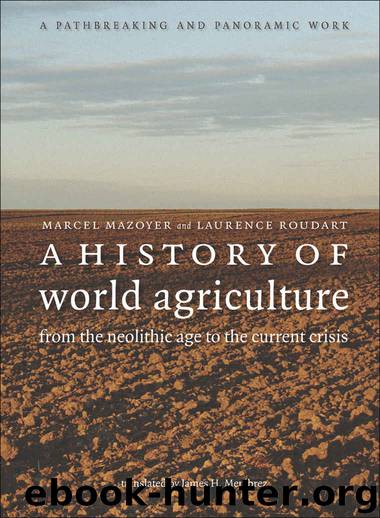A History of World Agriculture by Mazoyer Marcel & Roudart Laurence

Author:Mazoyer, Marcel & Roudart, Laurence
Language: eng
Format: epub
Publisher: Monthly Review Press
Published: 2006-05-31T16:00:00+00:00
The plot allotment corresponding to this new rotation can be represented in the following manner:
Triennial rotation includes, then, like a biennial rotation, a long fallowing that lasts more than 12 months and leaves time to carry out at least three plowings: the first in autumn, after the harvest; the second in spring, when the manure collected during the winter is buried; and the third in the following autumn, before sowing. The last plowing is completed with two runs using the harrow, one before and the other after the sowing. During the short fallow period, which lasts only 8 to 9 months, there is generally only one plowing. By means of all these operations, the soil is more thoroughly cleared, cleaned of weeds, broken up, and aerated than it was when cultivated with the ard. Triennial rotation also presents the advantage of lightening two very burdensome workload peaks. First, it allows the sowing to be divided into two periods rather than one and then it makes possible the lengthening of the harvest period by several days. The harvesting of spring cereals generally begins a little later than that of the winter cereals. Finally, another advantage is that the risks of a bad harvest are divided between two cultivation seasons rather than just one.
Triennial rotation, though long familiar, developed very slowly. Its use began to spread only in the thirteenth century, though cultivation using the plow had been expanding since the eleventh century. In the fourteenth century, biennial rotation was still the most widespread, and in the seventeenth century it was still used in several regions in the northern half of Europe. In order to explain this late development of triennial rotation, note first that such a rotation system was not necessary as long as a certain population density did not require a further expansion of cereal growing. But in regions with open fields and regulated plot allotment, the movement from biennial to triennial rotation required the entire rearrangement of arable lands. It was necessary to divide each segment (block of contiguous arable lands) into three plots instead of two, redivide each plot into parcels, and redistribute these among all the farmers so that each received as much land as before, equally divided among three plots. Thus there was a complicated process of land consolidation, which necessarily took a long time to become widespread.
We believe, however, that the deeper reason for this delay lies elsewhere. As long as hay meadows and larger herds were not yet widely developed, the amount of manure spread before the first cereal crop remained small, and the remaining fertility available the following year was inadequate for a second cereal crop. In order for triennial rotation to be more productive than biennial rotation, it is necessary that the yield of the second cereal crop be greater by one-half than the yield of the first: r1 and r2 being the yields of the first and second cereals, it is necessary that (r1 + r2)/3 > r1/2, that is, that r2 > r1/2.
Download
This site does not store any files on its server. We only index and link to content provided by other sites. Please contact the content providers to delete copyright contents if any and email us, we'll remove relevant links or contents immediately.
Periodization Training for Sports by Tudor Bompa(8170)
The Body: A Guide for Occupants by Bill Bryson(4974)
The MacArthur Bible Commentary by John MacArthur(4749)
The Sports Rules Book by Human Kinetics(4294)
What It Really Takes to Get Into Ivy League and Other Highly Selective Colleges by Hughes Chuck(3696)
Marijuana Grower's Handbook by Ed Rosenthal(3622)
The Sprouting Book by Ann Wigmore(3543)
The Martian by Andy Weir(3308)
Salt, Fat, Acid, Heat: Mastering the Elements of Good Cooking by Nosrat Samin(3108)
The Bread Bible by Rose Levy Beranbaum(3004)
Harry Potter 4 - Harry Potter and The Goblet of Fire by J.K.Rowling(2990)
Sapiens and Homo Deus by Yuval Noah Harari(2987)
The Marketing Plan Handbook: Develop Big-Picture Marketing Plans for Pennies on the Dollar by Robert W. Bly(2975)
Classic by Mary Berry(2942)
Martha Stewart's Baking Handbook by Martha Stewart(2796)
Screenplay: The Foundations of Screenwriting by Syd Field(2574)
The Plant Paradox by Dr. Steven R. Gundry M.D(2547)
50 Economics Classics by Tom Butler-Bowdon(2523)
The Cambridge Grammar Of The English Language by Rodney Huddleston Geoffrey K. Pullum(2382)
